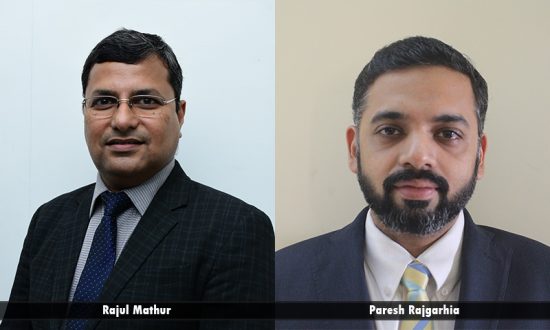Rajul is responsible for leading the Talent and Rewards business at Willis Towers Watson in India. He brings in a total experience of over two decades across operations, consulting and entrepreneurship. His specialisation includes visioning, business and change transformation, designing and implementing structure solutions, designing performance management systems, competencies, assessment, succession planning frameworks and design of rewards (STI, LTI, ESOPs) and Board evaluation and governance.
Paresh Rajgarhia is the Director of the Talent and Rewards business at Willis Towers Watson. Paresh has more than 16 years of work experience in areas of management consulting and investment banking. Prior to joining Willis Towers Watson, he has worked with Gallup (for almost a decade), where he was leading their business in South Asia. He has substantial experience in leading large transformational projects for Fortune 500 clients.
The number of organisations making employee experience a top priority has seen a considerable surge, as companies transition to new ways of work. But only a few are ready to address the challenges arising out of a new reality and work models post pandemic. In fact, India Inc. is abuzz with the real possibility of the great resignation phenomenon” may be upon us.
In the absence of a superior employee experience (EX) that meet their health and lifestyle demands with personalised and flexible offerings, employees are bound to look at new opportunities. A recent study found that almost all employers in India, were looking at enhancing the employee experience over the next three years compared to 74% employers, prior to the pandemic. Employers recognise the urgency of improving the EX as they adapt to their new reality and face turnover and engagement challenges.
Bridging the traditional and new forms of employee listening
Over the years, organisations have been relying on annual employee engagement surveys to meet an increasing number of goals, some of which include measuring and improving company culture, informing the design and rollout of companywide programmes such as rewards and career development, gauging reactions to discrete organisational changes (e.g. restructuring), and assessing progress on a particular company goal or initiative (e.g. to accelerate innovation).
However, the traditional annual survey undertaken by organisations as their sole means of employee listening, lacked data recency, customisation and measurement. The focus was only on one form of listening; not using any tools for advanced analytics and insights.
Thinking organisations realise that today’s workforces are far more complex than ever and comprise up of an intersection of multiple factors such as generations, nationalities, support for different social causes etc. Employees seek a highly customised, intuitive workplace experience often wanting to replicate the experience they have outside of work to their workplaces. To attract, engage and retain employees, it’s vital to ensure that they feel heard and know that their ‘asks’ as unique people, are being considered. In such a scenario, it becomes imperative to provide a consumer grade EX to employees.
It is imperative that organisations listen to their employees on a more continuous basis. The traditional annual assessment is too sparse for issues that change often, like – exit, feedback on initiative. However, increasing frequency of the assessment would be counterproductive for the monitoring of broader, more stable issues such as culture of an organisation. Organisations should therefore, carefully design their listening EX strategy that is integrated with the business. The strategy should incorporate annual surveys to understand broader themes and supplement it with frequent pulse surveys targeted at specific themes, topics, and demographics.
Shifting to more real time listening, real time analytics and behavioural change to drive a more personalised employee experience
EX as a strategy has evolved from the concept of customer experience. For instance, organisations in the airline or hospitality industry measure customer experience at each critical touchpoint (such as check-in/ boarding experience in airlines and check-in/ check-out experience at hotels). Organisations must work on mapping the entire employee lifecycle to seek feedback on all the touchpoints and moments that matter that people have while at work. EX initiatives have varied paces, which require more continuous forms of measurement. The agility of Virtual Focus Groups can reveal critical insights instantly. Leaders and managers need real-time advise in identifying issues that need to be addressed which may have a big impact on performance. Smart algorithms such as Natural Language Processing based sentiment analysis tools are now able to sift through complex sets of business and survey data to provide suggestions on the focus areas. EX is shaped by the organisation’s culture and strategy, and leadership needs to commit to building a truly great employee experience.
Employee experience breakthrough moments
Many organisations have identified flexible work as a priority to improve the EX in the near term. But many employers are not ready for this shift as they are not flexible regarding where and how work gets done, and very few are reimagining careers in response to changes in how work is accomplished. The actions that employers can consider to achieve breakthrough moments and better position themselves to address ongoing challenges and deliver a high-performance EX are:
- Adapting to flexible work by recharging strategies, programmes, and policies to address the emerging needs of flexible work
- Rebalancing EX offerings by focussing on the importance of designing and delivering Total Rewards, embedding inclusion and diversity (I&D) programmes, and creating a culture of wellbeing
- Equipping leaders and managers to lead through change
- Reconnecting with employees by adopting the hallmarks of transformative EX organisations to understand, listen to, communicate with and engage employees
- Building an integrated EX strategy that is integrated with the business strategy and powered by technology
Practically, adapting to the new reality will require some time and strong focus on graduating from legacy mindsets and practices, adopting the shift and putting sustained effort to keep the EX a top priority for post-pandemic recovery.


